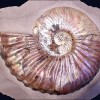Product Description
FOUND ON EVERY CONTINENT
Ammonite fossils are an incredible source of information for scientists, from dating rocks to confirming the presence of prehistoric seas. These extinct marine animals thrived in the Paleozoic and Mesozoic Eras, some 400 to 65 million years ago.
Ammonite fossils are found on every continent. And come in every naturally occurring color. Because of their rapid evolution and wide spread distribution they are an excellent tool for indexing and dating rocks. If an ammonite is found in clay the clay will preserve the Ammonites mother-of-pearl luster.
Ammonites began life very tiny, less then 1mm in diameter, and were vulnerable to attack from predators. They fed on plankton and quickly assumed a strong protective outer shell. They also grew quickly with the females growing up to 400% larger then the males; because they needed the larger shell for egg production. Most ammonites only lived for two years. Some lived longer becoming very large. The largest ever found was in Germany (6.5 feet in diameter).
Ammonites lived in shallow waters of 100 meters or less. They moved through the water by jet propulsion expelling water through a funnel like opening to propel themselves in the opposite direction. They were predators (cephalopods) feeding on most living marine life including mollusks, fish even other cephalopods. Ammonites would silently stalk their prey then quickly extend their tentacles to grab it. When caught the prey would be devoured by the Ammonites jaws located at the base of the tentacles between the eyes.
Most ammonites have coiled shells. The chambered part of the shell is called a phragmocone. It contains a series of progressively layered chambers called camerae, which were divided by thin walls called septae. The last chamber is the body chamber. As the ammonite grew, it added new and larger chambers to the opened end of the shell. A thin living tube called a siphuncle passed through the septa, extending from the body to the empty shell chambers. This allowed the ammonite to empty water out of the shell chambers by hyperosmotic active transport process. This process controlled the buoyancy of the ammonite’s shell.
Some Ammonites have intricate patterns on their shells called sutures. The different suture patterns tell us what time period the Ammonite is from.
Geometric = numerous undivided lobs and saddles; eight lobes around the conch is characteristic of the Paleozoic Ammonites.
Ceratitic = lobes have subdivided tips; giving them a saw-toothed appearance and rounded undivided saddles; Characteristic of the Triassic Ammonites.
Ammonitic = lobes and saddles are fluted; subdivisions are usually rounded instead of saw-toothed. This pattern is characteristic of the Jurassic and cretaceous Ammonites.
CLASSIFICATION:
Kingdom: Animalia
Phylum: Mollusca
Class: Cephalopoda
Subclass: Ammonoidea
– During medieval times ammonites were believed to be petrified snakes. They were fitted with carved heads and sold to pilgrims.
– The original discus used by the ancient Greeks in their Olympics was a fossilized ammonite!
– In India ammonite fossils are identified with the god Vishnu and are used in various ceremonies.
– The Navajo and Indians of the North American Plains carried ammonites in their medicine bags for health and good hunting. They called the ammonites buffalo stones because of their resemblance to the North American bison.









